Naturally Low Sodium Foods Babies Can Safely Eat
In this episode we're talking about:
- What negative associations with food and feeding are and how to avoid then
- How to reduce choking risk, vomiting and anxiety associated with BLW
- Why letting your baby get messy is part of the full sensory experience of learning how to eat

LISTEN TO THIS EPISODE
How can I help my baby have a positive relationship with food? And what should I avoid to help reduce negative associations with food and feeding for my baby? In this episode we’re going through some easy ways to help reduce vomiting, choking, anxiety and stress at mealtimes so that your baby can have the most positive eating experience possible.
SUMMARY OF EPISODE
In this episode we’re talking about:
What negative associations with food and feeding are and how to avoid then
How to reduce choking risk, vomiting and anxiety associated with BLW
Why letting your baby get messy is part of the full sensory experience of learning how to eat
PRODUCT LINKS FROM EPISODE
Online CPR Class - use affiliate discount code KATIE10 for $10 off this infant refresher CPR course: https://courses.thrivetraininginstitute.com/pages/babyledweanteam
Bapron Baby - best bibs for baby-led weaning and splash mats to go under the high chair, use affiliate discount code KATIE10 for 10% off, shop here: https://bapronbaby.com/discount/katie10
The Bapron Baby BLW bapron bibs and splash mats are also available on the ezpz website and affiliate discount code KATIE10 works for 10% off there too, shop here: https://shrsl.com/3qjoz
Free 1-hour video workshop training BABY-LED WEANING FOR BEGINNERS: learn how to safely prep BLW foods and get your copy of my original 100 FIRST FOODS list - click here to register for this week’s workshop times: https://babyledweaning.co/workshop?utm_source=Shownotes&utm_medium=Podcast&utm_campaign=Episode%20Link
OTHER EPISODE LINKS
Episode 71 - Travel + Restaurants: Taking Your BLW Show on the Road
TRANSCRIPT OF EPISODE
WANT MORE BLW INFO?!
SUBSCRIBE to the BABY-LED WEANING MADE EASY PODCAST - new episodes are released on Monday and Thursday and subscribing means you’ll never miss what’s new (+ you’ll get notified about special bonus episodes too!)...subscribe here.
Grab my free download called 10 EASY STARTER FOODS FOR BABY-LED WEANING - sometimes just getting the confidence to get going will help you realize your baby CAN and WANTS to do this self-feeding thing! < < CLICK HERE FOR THE 10 STARTER FOODS DOWNLOAD > >
REGISTER for my free online workshop BABY-LED WEANING FOR BEGINNERS: How to get your baby to try 100 foods before turning 1 without you having to spoon-feed purees or buy pouches. Everyone on the workshop gets a copy of my 100 FIRST FOODS list so you’ll know exactly what foods babies CAN eat when they’re ready for BLW! Register for this week’s workshop times here.

Latest Episodes
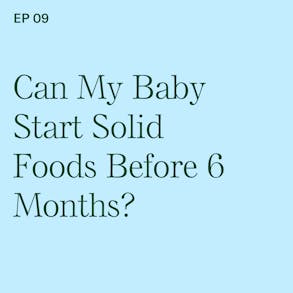
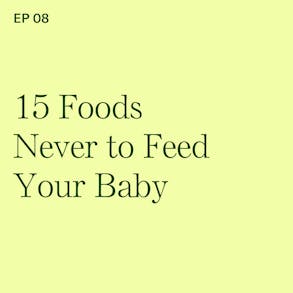
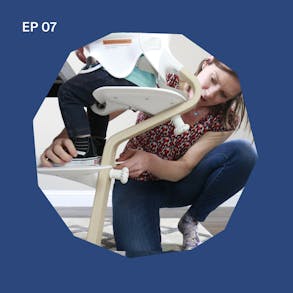
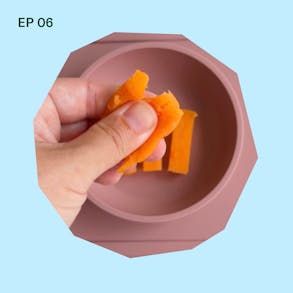
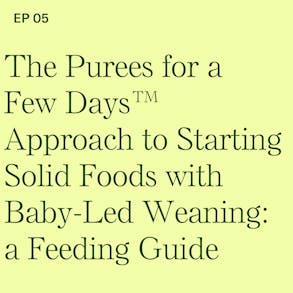
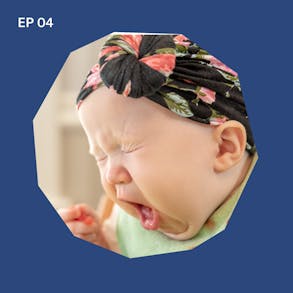
Katie Ferraro (1s):
Hey guys, Katie here. I hope you're enjoying the podcast and learning a lot about how to do baby-led weaning safely. I'm gonna be giving away some free Nomi Highchairs to three listeners, but I wanna ask you a favor first. I know you're super busy, but if you have two minutes, will you kindly leave me a review of this podcast on Apple Podcasts because reviews are everything for helping other parents find out about the podcast. And I read every single podcast review you write and I love and appreciate your feedback. And to say thank you for the reviews, I'm gonna be giving away a brand new Nomi highchair to three randomly selected reviewers if you submit your podcast review on Apple Podcast before midnight on Sunday, January 29th.
Katie Ferraro (40s):
Now the Nomi is hands down my favorite highchair for baby-led weaning. It has an adjustable foot plate and seat that don't require tools to change. And you guys know baby's feet resting flat on that solid foot plate are so key for facilitating a safe swallow for your baby. So if you wanna win one of the three Nomi Highchairs that are up for grabs, all you have to do to enter is leave a written review of the Baby-Led Weaning Made Easy podcast on Apple Podcast. And in your review, just be sure to drop your Instagram handle as your name on the review so that I can find you on Instagram and DM you when you win. If you've already left a review in the past, you can update your old review with anything new you like that you have to say and then you'll automatically be entered. Heads up, Nomi gets to select the color of the winner's highchair because their stock is limited, but I promise you'll like it.
Katie Ferraro (1m 23s):
This is like a $500 highchair and our way of saying thank you for listening. Your ship to address has to be in the United States and all new podcast reviews submitted now through Sunday, January 29th are eligible. So head to Apple podcasts and search Baby-led Weaning Made Easy to leave your review and get entered to win one of those three brand new Nomi Highchairs. I hope you win. Now let's get on the show. And if you're considering the allergenic foods and different ways to introduce your babies to cow's milk protein, take the example of paneer, right? Indian cottage cheese. There are certain brands of paneer that have like crazy high amounts of sodium. And then there's other ones like I know the national brand that they have, at least at my Costco in San Diego, is zero milligrams of sodium. So you can't just say like across the board like, oh, babies can't have paneer cause there's too much salt in it.
Katie Ferraro (2m 5s):
Cuz it definitely varies from brand to brand. And you do need to read your labels cuz there really are some great options out there for baby-led weaning. Hey there, I'm Katie Ferraro, registered dietitian, college nutrition professor and mom of seven specializing in baby-led weaning. Here on the Baby-led Weaning Made Easy podcast, I help you strip out all of the noise and nonsense about feeding, leaving you with the confidence and knowledge you need to give your baby a safe start to solid foods using baby-led weaning. Hey guys, welcome back. Today we're gonna be talking about some naturally low sodium foods that your baby can safely eat.
Katie Ferraro (2m 45s):
And sodium is always top of mind for parents when they learn about, oh gosh, I need to limit added salt. They're like, okay, but what exactly do you mean? So I like to start out these mini baby-led weaning training episodes with a BLW tip of the day. And my tip for sodium limits is because there's no hard and fast rules about how much your baby should quote on quote need to eat for salt or what the portion size for salt should be, I generally stick to 100 milligrams of sodium or less per serving of a package for processed food that I might be serving to the baby. Now the rationale there is that most of the foods that we offer to babies don't come out of packages and are not processed if you're doing baby-led weaning. So these are sometimes foods, but heck yeah, we gotta rely on some packaged foods from time to time.
Katie Ferraro (3m 28s):
And if you do get used to reading your labels, look for less than a hundred milligrams of sodium per serving if you can. Now the other thing to keep in mind is that your baby is not going to be eating the full adult portion size that's listed on the nutrition facts panel. So again, we're keeping our portion small, keeping our sodium small, but I generally feel comfortable offering my baby a food if it comes from a package as long as there's less than a hundred milligrams of sodium per serving. Some of the ones we're gonna talk about today will have zero, some will have slightly more, but the reality is there's lots of options out there that are naturally low in sodium and those are the ones we're gonna be tending towards. I'm gonna be sharing some of my favorite foods from each of the five food categories off of my a 100 First Foods list for you inside of this episode so you can get some ideas of like what are the lowers sodium foods?
Katie Ferraro (4m 16s):
And I kind of modeled this on, I don't know if depending upon how old you are, whether or not you remember the eat this not that series. So this is like starting in like the early 2010s. It was actually a column in Men's Health magazine that they kind of then spun off into this like whole media franchise. But eat this not that, ET NT, kind of like some people love it, some people hate it. Dietitians are like, I mean at least it's making people pay attention to what they eat, but a little bit arbitrary sometimes about how they pick the foods but they eat this, not that version of this episode is I'm gonna give you some ideas of high salt foods that you wanna steer clear of for your baby and then a naturally lower salt alternative that your baby can safely eat.
Katie Ferraro (4m 56s):
Now let's start out this training by going back to that recommendation, the BLW tip, this is my personal tip of trying to stick to less than 100 milligrams of sodium per serving. Now when you're looking at the nutrition facts panel, turn the package around zero in on sodium and you'll see how many milligrams of salt are in the portion size of the food that you're about to consider for your baby. Now on the front of the package though, there's lots of different language about salt and there's in order of like best two worst options for your baby, no added salt is always gonna be your best bet. Okay? No added salt means exactly what it says, that there's no additional salt added to this food product. Now next up on the list, sometimes you see very rarely it's called very low sodium.
Katie Ferraro (5m 37s):
So a very low sodium food in the United States. The labeling law is that if the food has 35 milligrams of sodium or less, that's very low sodium. Now parents sometimes will see low sodium and they're like, oh cool, low sodium. Low sodium isn't actually that low when it comes to babies because the labeling law for low sodium is that the product has to have less than a 140 milligrams of sodium per serving. So like low sodium is better than some higher salt bets, but it's still not falling underneath that a 100 milligram threshold. So I'm not actually offering a lot of low sodium foods to my baby. Then we have one that you almost never see anymore. This is much more popular in the 90s, like the low fat, low salt craze, but light in sodium L I T E or light in sodium L I G H T.
Katie Ferraro (6m 20s):
What that basically means is that there's 50% less salt than the standard reference product. So like back in the day there used to be regular wheat thins, which is a cracker that's high in salt cuz it's a processed commercial bread food. The light in salt wheat thins would have to have had 50% less salt than the super high salt wheat thins. That's what light means. What we do see a lot more of to this day is the next category, which is called reduced sodium. Okay? And reduced sodium just means that there's 25% less salt than that brand's standard reference items. So once a nice people will be asking about soy sauce, plain soy sauce as you probably wear is just liquid salt. Totally not appropriate for babies, but reduced sodium soy sauce, the one that comes in the green bottle, you'll hear people be like, oh, gimme the low salt soy sauce.
Katie Ferraro (7m 5s):
It's not low salt. You guys, the reduced sodium soy sauce just has 25% less salt than the super duper salty liquid salt, which is regular soy sauce. Okay? So the best bet is to look at the milligrams and if it says less than a 100 milligrams, then that's one that we're going to want to consider. Now, I mentioned that I have a 100 First Foods list. So the whole crux of my a 100 First Foods program is to help babies eat 100 safe baby-led weaning foods before they turn 1. And there's five food categories that make up the backbone of my five step feeding framework. Okay we introduce five new foods to your baby each week from the list. One from the fruit category, one from the vegetable category. We do one from the starchy category, one from the protein category, and then one from the allergenic foods category.
Katie Ferraro (7m 48s):
So those five new foods each week make up the backbone of this framework that you're building out to help your baby get to a 100 foods. So if we start with the fruits category, the good thing about fruits and vegetables you guys is that they are naturally low sodium foods, okay? And so obviously the fresher the better. Okay? If you're offering your baby a plain poached soft apple strip, there's not gonna be any added salt in there because you made it at home. You know, there's no salt. When we get towards the packaged and processed food aisles in the middle of the grocery store, that's when we're dabbling in salt, right? Because salt is of course the oldest and the cheapest preservative and flavor potentiator out there. People love the taste of salt, but you might be surprised to know that salt is actually an acquired taste.
Katie Ferraro (8m 32s):
You can actually wean yourself off of salt. I used to teach adult nutrition and weight loss and cardiology prior to specializing in baby-led weaning and one of the things we would teach is that it could take about six weeks for you to retrain your taste buds. So I'm married to my husband who loves salt, to the point where he salts everything I make before he tasted. I'm like, that's so rude. How do you know it's not gonna have enough salt? Cause I've known you for 15 years, I know you don't put enough salt. And I said, you know the way you eat, if I ate those foods, it tastes abhorrent to me. You could actually train your taste buds to not taste the salt. If you tomorrow started weaning yourself off of salt as an adult, six weeks from now, if you went back to eating the super duper salty foods that you did yesterday, you would be grossed out by the amount of salt. So when people would say, in my adult cardiology practice, oh, I'm addicted to salt, no, that's actually not true.
Katie Ferraro (9m 16s):
You can actually wean yourself off of salt. But with babies, we don't wanna do the reverse, right? We don't want baby to become accustomed to eating very high salt foods. We want our babies to learn how to taste the foods and the flavors and experience the taste and the textures of that food naturally, not in a highly processed salted version. So fruits and vegetables on their own are great foods because they don't have any salt added to them, but we can't always get access to all the fruits and vegetables that are fresh that we might wanna be preparing safely for our baby. So frozen and canned options are good, okay? There are better choices in the canned fruit and vegetable aisle and some not so great ones. Okay? When it comes to fruits, I did a whole episode on canned foods that canned work for your baby-led weaning.
Katie Ferraro (9m 58s):
That's back in episode 75. Kind of went through how to choose different canned fruits. You're gonna be more inclined to see added sugars in the canned fruit foods than you are to see added sodium. Since the vegetables where they add a lot of salt, the fruits where they add a lot of sugar, okay? But if you look on your label and then you see the ingredients, if it just says, let's say pears packed in their own pear juice or pears packed in water and there's no salt in the ingredient list, then when you go up to the sodium line, there will be close to zero milligrams of sodium. Because even though fruits contain lots of different vitamins and minerals, they tend to be, for the most part, quite low in salt. Okay? And even when you look at frozen fruits, okay, occasionally these like smoothie packets that you'll see in the frozen foods aisle will have added sugars.
Katie Ferraro (10m 42s):
We don't want those for babies. But frozen berries, frozen pineapple chunks, frozen mango slices, there's some great options in the frozen food aisle that have no added salt and no sugar. If for whatever reason you can't get fresh fruit or you choose not to do it or you don't wanna buy. Now, when it comes to vegetables, as I mentioned, the canned vegetables tend to be higher in sodium than canned fruits. However, you can always find no added salt versions of most of the vegetables on the 100 First Foods list. Okay? So episode 89, we talked about freezer foods and frozen foods. That was freezer aisle finds for baby-led weaning. And episode 75, we talked about the canned foods one. So if you're like, I can't get any of these foods fresh, don't stress, go back and listen to those episodes for ideas about canned and frozen foods.
Katie Ferraro (11m 24s):
But when it comes to fresh vegetables, please do be aware that certain vegetables, especially those dark leafy green vegetables, they're very rich in minerals, okay? And sodium happens to be a mineral. So sometimes you like to see, like if you looked at the nutrition fax panel of kale, okay? When you go to the grocery store and you buy kale out of the produce aisle, there's not a label on it, but let's say you went online, you looked on the USDA website. Oh my gosh, there's actually some sodium in kale that's naturally occurring sodium. Okay? We're concerned about added salt for babies and wanting to avoid them. Hey, we're gonna take a quick break, but I'll be right back.
Katie Ferraro (13m 6s):
Now, of course you can take any vegetable and if you're my husband, put a whole bunch of salt all over it. That's definitely not what we wanna be doing for babies when we prep the foods for the babies, just remove the soft portion for the baby before you add salt to your adult portion. We do again, wanna be offering fresh fruits and vegetables for babies that don't have salt. A food that's really been exciting for me as a baby-led weaning specialist are already prepared beets. So I've shared on the podcast before, but like beets are a food that I just can't tolerate. Like I can't handle the texture. It totally makes me gag. The smell of beets cooking makes me gag. Yesterday I had a salad that had Swiss chard in it, which is from the beet family and like it was so beet tasting to me, which tastes like dirt that I couldn't even finish it. So I don't like prepping beets, but beets are one of the foods on the 100 First Foods list.
Katie Ferraro (13m 48s):
Very rich in nutrition. I love to serve beets to babies, but you can buy these already cooked, peeled beats. So there's a couple of different ones. There's a brand called Love Beets. They have them at Costco. Now this is not sponsored by any means, but they just have cooked, peeled bets and sometimes they have vinegar added to them, which is totally safe for babies to have. It doesn't, as long as it's unseasoned, which means unsalted vinegar, your baby can have it. But I love these products because it's kind of like a convenience food. A lot of times with convenience food, you get the convenience of the food already being prepped, but they're gonna add salt and sugar in a bunch of junk your baby doesn't need. But that's not the case with the beets that are already cooked and peeled for you. Saves you so much time. I think that's a convenience food that's totally worth it.
Katie Ferraro (14m 28s):
And I love that that brand isn't adding any salt to their cooked product. You can always go add the salt if you want to afterwards. Alright, let's move on. We've got fruits, got vegetable done. Let's take a look at the starchy foods category of the 100 First Foods list. This is the one where parents are like Katie, I love the idea of offering my baby something besides rice, pasta or potatoes for carbohydrate, but there's all these random, whole grains and I'm not really used to those foods. One of the things about whole grains is that if you look through the whole grains on the 100 First Foods list, I usually talk about them cause I love how much iron is in a whole grain food, but they're also naturally low in sodium. And when people think about starchy foods, oftentimes they think about bread. Just spend like five minutes in your bread aisle and see if you can find a low sodium bread.
Katie Ferraro (15m 11s):
Spoiler alert, you can't because commercial bread is very high in salt, okay? And salt serves a number of different purposes. It's a preservative, okay? It also retains moisture, so it makes bread nice and moist. If you've ever had low salt bread, it's like super duper dry. And as you know, we don't offer dry products to babies like dry carbohydrate foods or dry protein foods. So occasionally families will ask about bread. You know, why don't you have bread on your 100 First Foods list? I am comfortable doing bread for babies a little bit later. So I talked about that. We did a whole episode on bread, actually. It was called Bread. When Can Babies Safely Eat Bread? That was episode 183. And there is a brand called Ezekiel Bread that you usually can find in the frozen aisle of your grocery store.
Katie Ferraro (15m 53s):
If they don't have it in the bakery. It's a low sodium bread, but you gotta add a lot of moisture to it because when you take the sodium out of the bread, it does, as I mentioned, make it very dry. So instead of bread, which down the entire bread aisle has too much salt for your baby, how can you offer your baby carbohydrate or starchy foods? Well stick to those whole grains, okay? A lot of whole grain convenience foods will have like really salty sauces added to them, but the whole grain by itself, the sorghum or the buckwheat or the quinoa, those foods are naturally going to be low in salt. Now if you're making them for your family, you hear, I mean I like sorghum, but like I don't like plain sorghum. Popped sorghum is actually really good. It's like one of my family's new favorite snacks. They call it mini popcorn, but we don't offer popped foods like popped sorghum or popcorn to babies cause it could be a choking hazard.
Katie Ferraro (16m 36s):
But if you're making those as whole grains in place of pasta, potatoes, or rice, you usually are gonna make it in some sort of a dish that has a sauce. And so one of the problem with commercial sauces, if you buy things like salad dressings or you know, if you buy a chimichurri sauce already made, or you buy any sort of, you know, hummus, et cetera, sauces, dippers, toppers, which we talked about using to moisten up foods for babies. They tend to be too high in salt when you buy them in the store. Well, our team went through and picked our five favorite sauces and made five low sodium sauce recipes for baby-led weaning. So this is a free feeding guide if you're looking for like sauces to go with some of these foods that you're making for your baby that are also low in sodium, make sure to download the free five low sodium sauces to make food safer for swallowing.
Katie Ferraro (17m 19s):
And I will put that link in the show notes page for this episode. If you click below right where you're listening to the podcast, you can link out to that free feeding guide or if you go to blwpodcast.com/ 301, you can grab that free feeding guide with those sauces. But steer clear of the commercial breads, which are too high in salt and instead, pick some of those wacky whole grains from the 100 First Foods list and notice how low in salt they are, not to mention high in iron and a good source of plant protein. And if you don't have a copy of my original 100 First Foods list yet, I give it to everybody on my free one hour video workshop called Baby-led Weaning for Beginners. You can sign up for this week's workshop times, grab that hundred first foods list with the 20 whole grains.
Katie Ferraro (17m 59s):
That's all for you @babyledweaning.co. Again, head to babyledweaning.co for that free baby-led weaning for beginners workshop with the 100 First Foods list on it so you can get started offering your baby low sodium whole grains today. All right, next category from the hundred first foods list are the protein foods. Okay? When it comes to making meats, I would say after whole grains, this is the one where a lot of parents are like, Ugh, I like meat, but I don't make a ton of it or if I do, I go like the convenience route like carne asada, that's already seasoned, or I'm gonna buy a chicken that's already seasoned. And if you start reading the labels in the meat section at your grocery store, you'll see that the meat by itself is not the problem. It's the prepared versions of the meat which are pumped oftentimes full of very high salt juices, right?
Katie Ferraro (18m 45s):
If you think about it, they're selling you meat by weight, right by pound or by kilogram. And if you inject it with a lot of high sodium ingredients that retain a lot of water and plump it up, you're basically buying some watery juiced up meats, which when they have a lot of salt in them, are therefore not appropriate for your baby. So stick to the plain versions of the meats on the 100 First Foods list, okay? If you're doing lamb or if you're doing pork, or if you're doing chicken, or if you're doing beef, poultry is another one. Turkey. Okay? We have turkey on the 100 First Foods list. We talk a lot about the benefits of doing the dark meat of poultry, the legs, the wings, the thighs for baby-led weaning because there's more fat in those cuts versus like the turkey breasts or chicken breasts, which is just pure protein and totally dry.
Katie Ferraro (19m 25s):
Not safe for babies to swallow. But I love the higher fat cuts of poultry, but sometimes parents will be like turkey, so do you mean like lunch meat turkey? No, no, no, no, no. Okay, eat this, not that. Steer clear of the lunch meat turkey. Okay? And look for whole turkey. My sister got me an XL deep fryer for Christmas, not because I asked for it or wanted it, she's just like, you don't have a fryer. I was like, dude, I'm a dietitian. I probably don't have a fryer, but I freaking love this fryer. And I deep fried a turkey the other day and it was so amazing. The legs, the wings, the thigh, still gonna be on the fattier side even with the fried turkey. But I was thinking about it like, I'm here, I'm making my whole turkey versus like, and literally what the turkey cost, it was actually on sale.
Katie Ferraro (20m 8s):
It was so much more affordable to make that turkey per portion than it is to buy it already prepped or certainly to buy lunch meat. Like lunch meat is so crazy. My kids are like, how come we never have turkey sandwiches? And then my daughter's like, oh, it's cause it has too much salt. Mom doesn't like it. I was like, no, it's also just like way too expensive. So if you can make yourself a whole bird, okay, it's really not that hard. You don't have to make a whole turkey. If you guys just have an instant pot. Okay? One of my favorite baby-led weaning recipes is from Jenna Helwig's Slow Cooker Baby Food Cookbook. You take a whole chicken, you put it on the rack in your instant pot, you put one cup of water in there and then you pressure cook it on high for 25 minutes. Okay? And then you have like the easiest, softest, fattiest, shreddable chicken.
Katie Ferraro (20m 50s):
Save that low sodium broth. Put it out there for your baby to eat. So much cheaper and so much lower in salt for your baby. So steer clear of the processed lunch meat aisle and try to make, even if it's a little bit of a stretch for you, the actual meat for your baby, because it's a very important taste and texture experience. Not to mention there's a lot of iron in those animal foods like turkey and chicken. Hey, we're gonna take a quick break, but I'll be right back.
Katie Ferraro (22m 33s):
Alright, so there you go. For protein, oh and seafood, we have some of the different seafood foods on the allergenic side of the 100 First Foods list, but because it also is a protein, I'll mention it here. Is that some types of shellfish and fin fish, because they are high in minerals, will also have like perhaps a little bit higher sodium content than you might have thought. But again, especially if you're buying like canned seafood, canned shellfish, if you look at the ingredient list and it just has the name like clams, okay, and it doesn't say sodium or salt after that, then the amount of sodium that's in the food label there is just from that naturally occurring salt that's inside of the shellfish. So certain categories of food, especially the dark green leafy vegetables and types of the shellfish and fin fish, a little bit higher in sodium.
Katie Ferraro (23m 13s):
But if it's not added sodium, it's totally fine for your baby to have. Another cool protein food, cause our protein foods list has, it's split into animal and plant-based protein foods and then cheese's. Parents ask about a lot too, because cheese contains cow's milk and cow's milk is one of the allergenic foods, but as you know, through the preparation to make cheese, it usually involves adding a lot of salt. There are some lower sodium cheeses out there though, and I like the soft cheeses and it's like ricotta for example, is a wonderful first food for babies. It's a great way to introduce your baby to cow's milk protein. Super important if your baby's exclusively breastfed, right? Cause if they haven't had formula, they haven't yet had exposure to that cow's milk protein. But we want your baby to have cows milk protein early and often to help reduce the risk of cows milk, protein allergy down the road.
Katie Ferraro (23m 57s):
So I like some of those softer cheeses. Paneer is one. There's certain brands of paneer, it's kinda like Indian cottage cheese, a softer cheese. Some brands have so much salt. And then there's one national brand, they actually carry it at Costco in the United States, at least where I am in San Diego that has zero milligrams of added sugar. So you can't just write off a whole food and be like, oh, babies can't eat paneer cause there's too much salt. Because from brand to brand, some may have zero milligrams and some may have a lot. You really do just need to read your labels. All right, last category of the 100 First Foods list. Looking for some low sodium option in the allergenic foods category. So there are nine foods that account for about 90% of food allergy in North America. Okay? Now our allergenic foods list actually has 20 different foods on it because it has the same protein with some variations, right?
Katie Ferraro (24m 38s):
You want to introduce your baby to these allergenic foods early and often. You don't just like do shellfish once and then you're done and be like, oh, we did it and the baby's, you know, had shellfish. Yeah, they had it once. But you need to introduce these allergenic foods early and often. So the three that I usually start with, peanut, egg and milk, you don't have to, I've definitely done all of the nine allergenic foods in week one of baby-led weaning, not at the same time, but like with different babies just to show you that you really could pick any of these allergenic foods that you want to. But I like peanut, egg, and milk because those are the three most common pediatric food allergies. They tend to be foods that depending upon your food culture, most families at least in North America would have or have some exposure to or familiarity with. When think about peanuts though, intact nuts or thick gloves of nut butter are a choking hazard.
Katie Ferraro (25m 19s):
So we teach about how to thin out smooth, unsalted, unsweetened peanut butter. You can usually mix that with breast milk or formula or you can mix it with unsweetened apple sauce to make a nice thin puree that slides easily off of your stainless steel spoon. That then means that it would be also not inclined to stick on the roof of your baby's mouth. So we thin the peanut butter out to lower the choking risk, but if you look at peanut butter, it goes all over the board from the amount of sodium. So you actually can find unsalted peanut butter. And if you're going to do the thinned out peanut butter, just make sure you're buying the unsalted peanut butter. Same thing with almond butter. If you're using thinned out almond butter as a way to introduce your baby to tree nut. Okay, now I prefer to just kind of lazy and I don't like peanut butter.
Katie Ferraro (25m 59s):
I love to use the baby peanut puffs from the brand Puff Works Baby, as the way that I introduce babies to peanut protein. Puff Works also makes an almond puff, which is a great way to introduce baby to a separate allergenic food category, that's tree nuts. But the puffs from Puff Works have just a very, very tiny amount of salt. It's only five milligrams per serving and that's just for preservative purposes. But if you look at some of the other brands of peanut puffs out there, they'll have lots and lots of salt, which is not appropriate for babies. Plus some of the other national brands will have lots of added sugar as well. You wanna make sure we're doing zero grams of added sugar for baby and then look as close to zero as you can for sodium. I always say less than a hundred, but I love Puff Works Baby because they have just a tiny amount of salt and plus they're the softest puffs on the market.
Katie Ferraro (26m 44s):
So these are great for baby-led weaning. If you wanna introduce your baby to peanut protein, I'm an affiliate for Puff Works and my affiliate discount code BABYLED. That's baby l e d. Works for right now. I think it's 15% off @puffworks.com if you wanna get a case of baby peanut and a case of baby almond to start, you don't even have to worry about the salt there. And if you're looking at some of the other foods in the allergenic food category, you talked about how shellfish is actually different from fin fish. Okay? And occasionally they'll be slightly higher in sodium cause they're just high mineral foods. Just be careful to read your labels there. You can always, especially tinned fish and find lots of great options in the canned food aisle of your grocery store. Read closely just to make sure that there's no salt in the ingredient list, and then that's the food that would then be okay to serve to your baby.
Katie Ferraro (27m 27s):
When it comes to those cheeses, the soft cheeses tend to be lower in sodium than some of the hard cheeses or things like mozzarella and ricotta. You're gonna see that there are lower sodium options for your baby, and that's a great way to introduce your baby to the potentially allergenic food cows milk. So just some tips on how to kind of steer towards the lower sodium options in each of the food categories. Again, if you wanna grab that 100 First Foods list, it's on my free one hour video workshop called Baby-led Weaning For Beginners. This week's signup times are @babyledweaning.co. If you wanna get that free feeding guide with the five low sodium sauce recipes, I'll link that up in the show notes, which you can find @blwpodcast.com/301.
Katie Ferraro (28m 11s):
A special thank you to our partners at AirWave Media. If you guys like podcasts that feature food and science and using your brain, definitely check out some of the podcasts from AirWave. We're online @blwpodcast.com. Thank you so much for listening, and I'll see you next time.
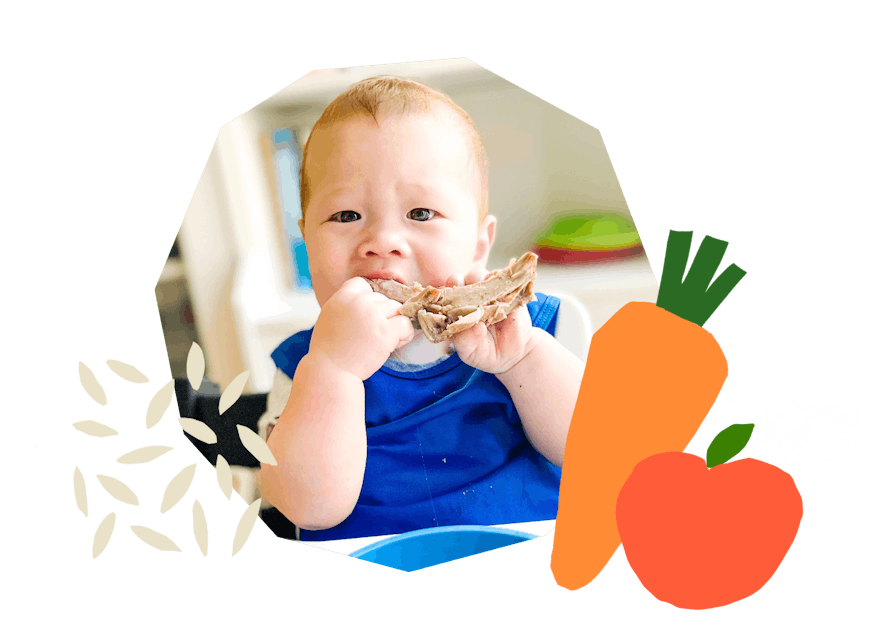
The Program Baby-Led Weaning with Katie Ferraro
A step-by-step digital program for starting solid foods safely and navigating the original 100 FIRST FOODS™ meal plan with baby-led weaning.
 EXPERT-LED, PROVEN APPROACH TO EATING REAL FOOD
EXPERT-LED, PROVEN APPROACH TO EATING REAL FOOD CONCISE VIDEO TRAININGS TO MASTER BABY-LED WEANING
CONCISE VIDEO TRAININGS TO MASTER BABY-LED WEANING 100 FIRST FOODS DAILY MEAL PLAN WITH FOOD PREP VIDEOS
100 FIRST FOODS DAILY MEAL PLAN WITH FOOD PREP VIDEOS
Baby-Led Weaning for Beginners Free Workshop
Is your baby ready to start solid foods, but you’re not sure what to do? Register for this free online video workshop and learn how to give your baby a safe start to solid foods using baby-led weaning. Everyone on this free training receives a copy of Katie’s original 100 FIRST FOODS™ list. You can take this workshop right now, later today when your baby naps, or tomorrow…whatever works for you!
Get baby-led weaning recipes and tips delivered to your email inbox.